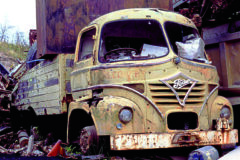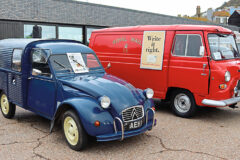Classic fairground rides and transport
Posted by Chris Graham on 28th February 2023
David Vaughan takes a look at the less-noticeable side of the fairgrounds, and the interesting rides and transport found among them.
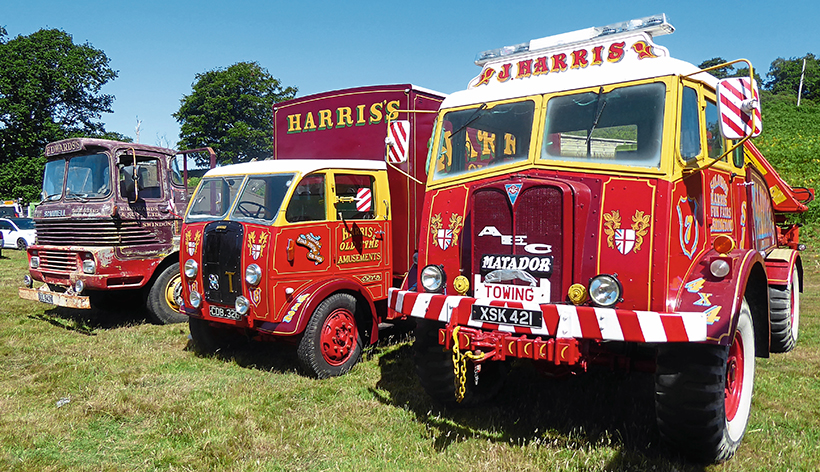
Rides and transport: The Thornycroft Sturdy is seen here in the line-up of Harris’s vehicles at Parham Park in July 2022. (Pic: David Vaughan)
The history of local fairs goes back to the 12th century, when towns or cities were often granted royal charters to hold an annual fair, an event that would draw crowds from all the nearby villages and hamlets and was often held in conjunction with a local livestock market.
My earliest memories are of a fair that came to a field at the eastern end of Eastbourne where I then lived on a newly-built council estate. Fairs were always exciting places full of noise, smells and twinkling lights. Money was scarce and the few pennies that jingled in the pocket of my short trousers had to be carefully spent, so one ride or a couple of goes on a hoopla stall in hope of winning a cheap toy or a goldfish was all I could afford.
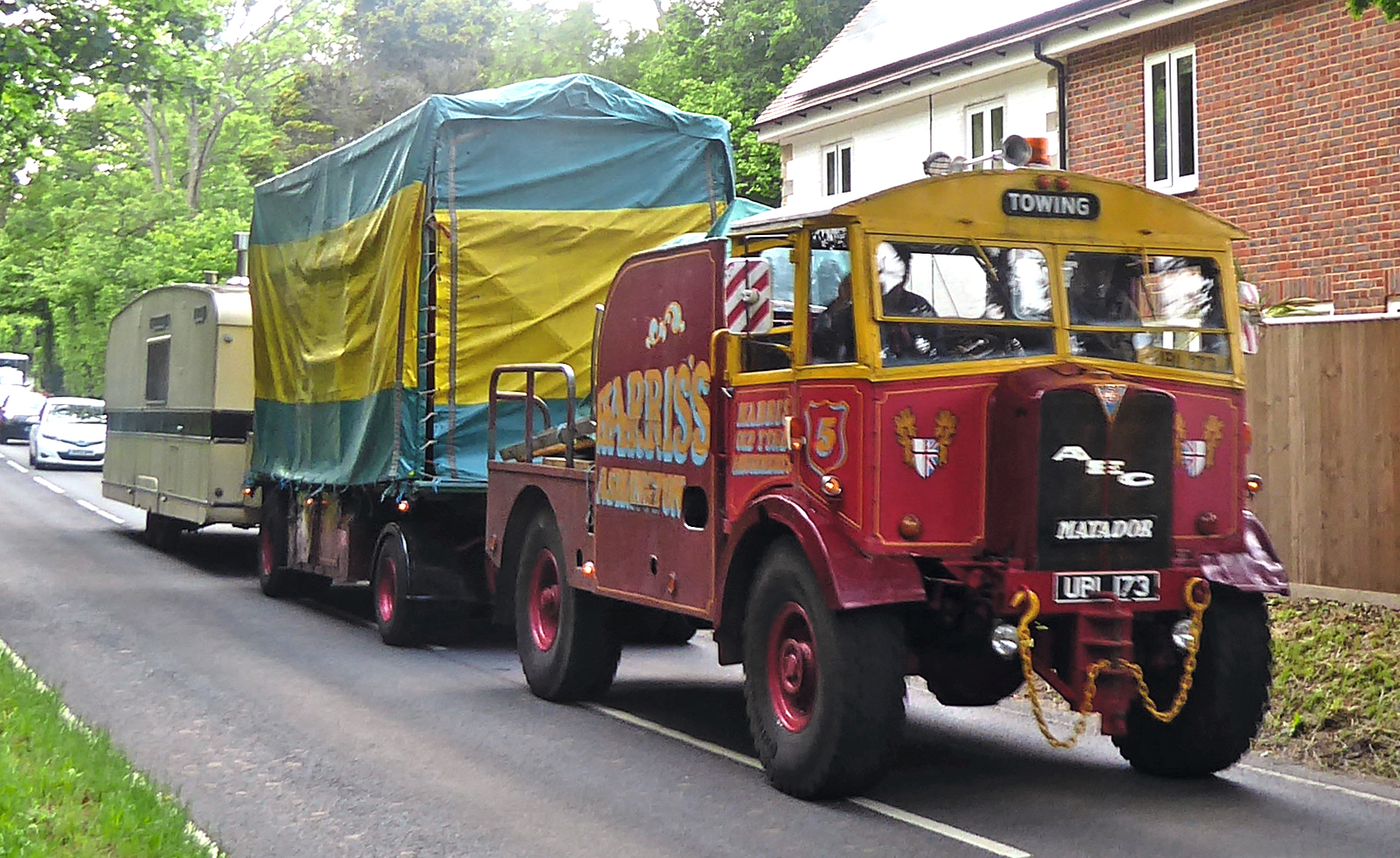
Harris’s famous gallopers arriving at Tinkers Park for the June 2022 steam rally, with the load being pulled by one of their reliable AEC Matadors. It is good to see what is probably the last example of a traditional Victorian-style funfair road train on the road. (Pic: David Vaughan)
To me, however, the great thrill came from exploring behind the rides, often at the peril of barking guard dogs, or simply being told to ‘Buzz off!’ The reason for my forays into this side of fairground life was my interest in the vehicles. By that I mean the old lorries or buses that had been converted by the showmen to tow the trailers containing the rides, side shows or the caravans of the show-land folk.
The lorries also served to carry the generators for the lights and to drive the rides. Every one of these vehicles had already endured a hard life on the road hauling goods or carrying passengers, often clocking up hundreds of thousands of miles.

Solly Harris’s recently acquired Thornycroft Sturdy with a Perkins diesel badge and the ex-Mighty Antar ‘T’ adorning the radiator is seen on one of its first outings, at Tinkers Park in June 2022. (Pic: David Vaughan)
Fairground operators were adept at doing running repairs or bodywork conversions and were especially fond of Gardner-powered vehicles, so makes such as Foden, ERF and Scammell often appeared in the ranks. The generating sets were also mainly Gardner-powered. Also one could spot radiators with badges from makes like Guy and Bristol that had originally adorned the front of half-cab buses or coaches. Old PSVs were also popular as living accommodation, often with the addition of long roof racks able to carry a side sheet or part of a juvenile ride.
In this monthly series we hope to show readers a selection of lorries, rides and fairground scenes to whet your appetite. Maybe you, like me, have fond memories of the fairs of the 1950s, ’60s and ’70s that you would like to share.
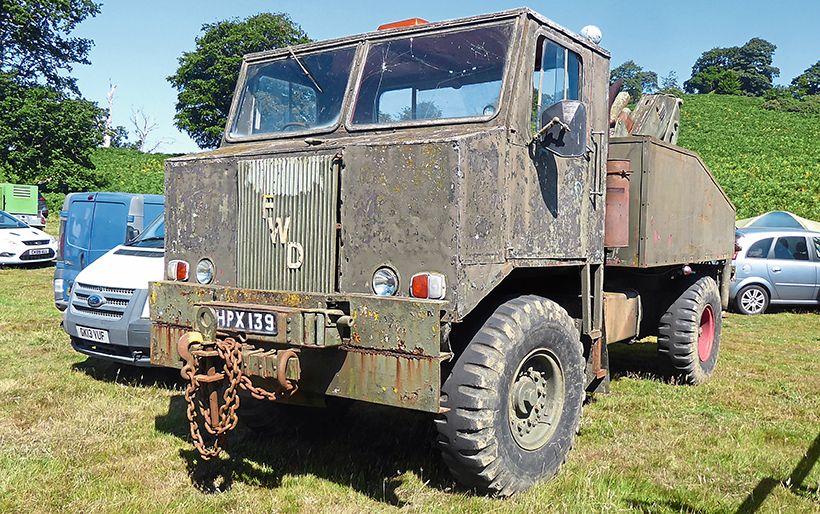
Harris’s used to run this ex-army FWD and have brought it out of retirement for the return of the Parham Park rallies where it last operated. It was not however used to tow the rides this time. It would be nice to see this veteran of the road train brought back into full Harris livery. FWDs were once popular with showmen as they were cheap to buy from the ex-army auctions and very sure-footed on wet ground. (Pic: David Vaughan)
Harris’ of West Sussex
Harris’ Funfair is well known for its traditional rides and the vintage lorries it uses to pull the rides to the next event. The family firm is based in Ashington, West Sussex, and it has been associated with fairs in the south-east since the early 1800s. A recent addition to the fleet is a neat little Thornycroft Sturdy dating from 1946. it is owned by family member Solly Harris, one of the younger members of the family team, and has an interesting history.
It was originally a tower wagon for a tramway company and came from Stockport in Cheshire. After service there it went far north to the Orkney Islands where it had its chassis lengthened and was used for a number of years as a coal lorry. Both jobs would not have involved heavy mileages and so it was probably in fairly good condition when it went back to the mainland where it was housed at Beamish museum. They obviously did not have much use for it and it was sold to a private buyer and subsequently Solly bought it and drove it back to Sussex.
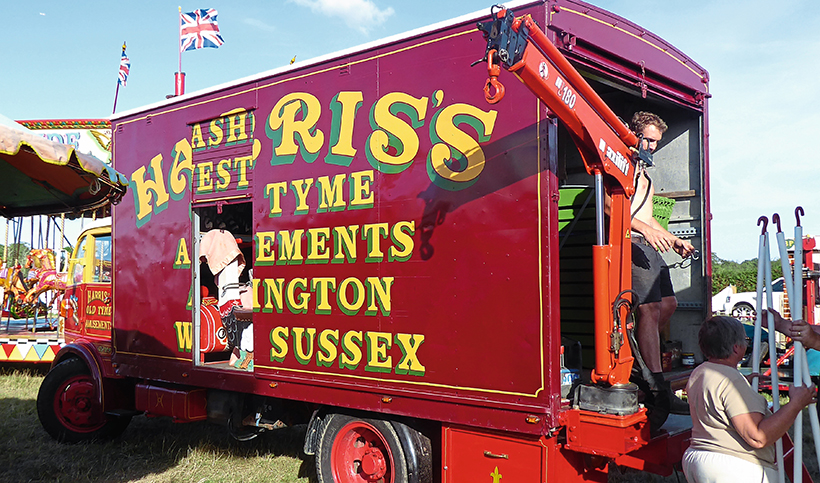
The little Maxilift loader is assisting Solly and helpers with packing up the ride at the Hellingly Festival of Transport. (Pic: David Vaughan)
Solly operates a juvenile roundabout ride and previously ran a Ford Cargo which was getting rather age-worn. Wanting something suitably vintage to go with the AEC Matadors and Scammells of the family fleet he thought the Thornycroft ideal and transferred the box body from the Ford to his new acquisition. He put a Perkins P4 engine in it and did the superb sign-writing himself.
Another interesting fact about this lorry is the big ‘T’ badge on the radiator, the trademark of Thornycroft vehicles. In fact it came from a Thornycroft Mighty Antar found in Hardwick’s scrapyard several years before and was displayed in one of the family’s living vans. Naturally Solly though it was just right for his lorry. I first saw the Trusty at the Tinkers Park rally which the Harris brothers have supported for over 50 years and, in July, it was with the fair at Parham Park rally.

Another of the Harris’s AEC Matadors is seen here with a packing truck being loaded. Note that every available space is used, including a large ‘belly box.’ Care has to be taken to load each piece of the ride tidily and in the right order so it is ready for unloading at the next site and nothing breaks loose during transit. (Pic: David Vaughan)
The Harris family are now probably the only showland family still running regularly with traditional Victorian-era rides transported by a fleet of vehicles dating back to the 1940s .
Nowadays fairground rides are often erected using hydraulically-powered lifting equipment that is part of the ride itself. This still calls for skill and muscle power, as well as checking the stringent safety measures before the ride can be made operational. The older, more traditional rides toured by Harris brothers almost totally rely on manpower to erect and take down at the beginning and end of each show. This is a lengthy business and calls for extra care on the part of the work crew to avoid accidents.

Also seen at Parham was this ex-Edwards packing trailer used for their ‘Continental Dodgems’.
(Pic: David Vaughan)
At the Festival of Transport that took place at Hellingly in East Sussex over the August bank holiday I witnessed the Harris crew members taking down their set of gallopers and the popular chair-o-plane rides. I have included some pictures of this to give readers some idea of the sort of work travelling a traditional fair involves as, now that the Carters have sadly withdrawn from the scene, it is a sight we shan’t see very often.
This feature comes from a recent issue of Old Glory, and you can get a money-saving subscription to this great magazine simply by clicking HERE



